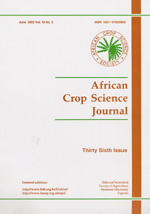
|
African Crop Science Journal
African Crop Science Society
ISSN: 1021-9730
EISSN: 1021-9730
Vol. 24, No. s1, 2016, pp. 35-44
|
 Bioline Code: cs16012
Bioline Code: cs16012
Full paper language: English
Document type: Research Article
Document available free of charge
|
|
|
African Crop Science Journal, Vol. 24, No. s1, 2016, pp. 35-44
| en |
Optimisation of a somatic embryogenesis and transformation protocol for farmer-preferred cassava cultivars in Kenya
Marigi, E.N.; Masanga, J.O.; Munga, T.L.; Karanja, L.S.; Ngugi, M.P.; Thagana, W.M.; Kirubi, D.; Mwangi, M.; Githunguri, C.M.; Muiru, W.M.; Miano, D.W.; Alakonya, A.E. & Oduor, R.O.
Abstract
Cassava ( Manihot esculenta Crantz

) is a major food crop in developing countries, and holds potential for industrial use. It is, however, affected by various biotic and abiotic stresses that greatly affect its production. The existing regeneration and transformation protocols are not compatible with all cassava cultivars, thus efficient and robust transformation and regeneration protocols for farmer-preferred cultivars need to be optimised for ease of transfer of novel genes. The objective of this study was to develop an efficient transformation and regeneration protocol for a farmer-preferred Kenyan cassava cultivar. We cultured immature leaf lobe and stem explants on Murashige and Skoog (MS) medium, supplemented with varying concentrations of 2,4-dichlorophenoxyacetic acid (2,4-D), Picloram and á-naphthalene acetic acid (NAA). Plants were recovered on media with 6-Benzylaminopurine (BAP) and GA 3 under a 16 hour light/8 hour darkness photoperiod regime. Results showed high regeneration and transformation frequencies for both cultivars. High frequencies of callus induction (>98%) for both cultivars, were obtained when 2,4-D and Picloram were used. Similarly, both auxins initiated somatic embryogenesis, with Picloram producing the highest frequency of somatic embryos (>92%) in TMS 60444, using stem explants. Gus assays revealed high frequencies of transformation of >77% (TMS 60444) and 60% (Kibanda meno mkubwa). This protocol offers promising perspectives for rapid improvement of these cultivars and, therefore, provides a platform for cleaning planting materials, as well as cassava genetic improvement programmes such as control of viral diseases.
Cytokinin; Manihot esculenta; regeneration protocol
|
| |
| fr |
Marigi, E.N.; Masanga, J.O.; Munga, T.L.; Karanja, L.S.; Ngugi, M.P.; Thagana, W.M.; Kirubi, D.; Mwangi, M.; Githunguri, C.M.; Muiru, W.M.; Miano, D.W.; Alakonya, A.E. & Oduor, R.O.
Résumé
Le manioc ( Manihot esculenta Crantz

) est une culture vivrière de grande importance pour les pays en développement, avec un potentiel pour l’usage industriel. Néanmoins, le manioc est sujet à des stress d’origines biotique et abiotique, affectant sa production. Les protocoles de régénération et de transformation existante ne sont pas compatibles avec toutes les accessions de manioc. Ainsi, il est nécessaire de développer des protocoles de régénération et de transformation efficaces pour les accessions adoptées par les paysans, afin de faciliter les transferts de gènes d’intérêt. L’objectif de cet etude était de développer un protocole de régénération et de transformation adapte a la variété de manioc. Des feuilles et tiges immatures ont été cultivées sur des media Murashige et Skoog (MS), auxquels différentes concentrations de 2,4-dichlorophenoxyacetic acide (2,4-D), Picloram et á-naphtalène acétique acide (NAA). Les plantes ont été recouvertes de 6-Benzylaminopurine (BAP) et GA 3 sous une photopériode de 16h jour/8h nuit. Les résultats ont montré des fréquences élevées de régénération et de transformation pour les deux cultivars Kibanda meno mkubwa et TMS 60444. Des fréquences élevées d’induction de callosités (>98%) ont été obtenues pour les deux cultivars, lorsque 2,4-D et Picloram ont été utilisés. De la même façon, les deux embryogenèses somatiques initiées a l’auxine, avec des explants de tiges et du Picloram ont exhibe la fréquence la plus élevée d’embryon somatique (>92%) en TMS 60444. Des essais de Gus ont révélés des fréquences élevées de transformation >77% (TMS 60444) et 60% (Kibanda meno mkubwa). Ce protocole offre des perspectives pour l’amélioration rapide de ces cultivars, et par conséquent, fournit une plateforme pour la production de matériels de culture propres, mais aussi servira d’outil dans les programmes d’amélioration génétique visant la lutte contre les maladies virales.
Cytokinine; Manihot esculenta; protocole de génération
|
| |
© Copyright 2016 - African Crop Science Journal
|
|
